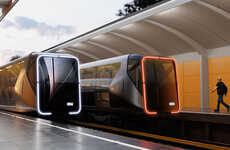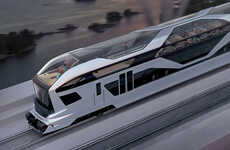
Non-Stop Metro Rail Transit
Alex Covert — June 18, 2008 — Autos
References: dvice
Taiwanese inventor, Peng Yu-lun, has designed a non-stop passenger train. It takes a lot of energy to start and stop a moving train due to something called inertia (mass x speed). Awesome! Wait a minute. How do you get people onto a moving vehicle?
That's the beauty of Peng Yu-lun's non-stop MRT system. It uses smaller shuttles to move passengers on and off of the larger one. You don't want to miss this connecting flight.
That's the beauty of Peng Yu-lun's non-stop MRT system. It uses smaller shuttles to move passengers on and off of the larger one. You don't want to miss this connecting flight.
Trend Themes
1. Non-stop Transit Systems - Innovative transportation solutions that reduce the time wasted on starting and stopping trains by utilizing smaller shuttles to bring passengers on and off will revolutionize commuter experiences.
2. Inertia-reducing Technologies - New methods of reducing the amount of energy used to start and stop trains, such as Peng Yu-lun's MRT system, will help decrease the environmental impact of public transit.
3. Automated Passenger Transfer - Developments in technology that allows for seamless transfers of passengers between stations and moving vehicles will greatly improve the efficiency of transportation systems.
Industry Implications
1. Public Transit - The implementation of non-stop transit systems such as the MRT could drastically improve the efficiency of existing public transport systems.
2. Transportation Infrastructure - Incorporating inertia-reducing technologies in transportation infrastructure design could help mitigate the environmental impact of mass transit systems.
3. Smart City Development - The development of automated passenger transfer technologies can play a vital role in creating more efficient and sustainable smart cities.
3.2
Score
Popularity
Activity
Freshness























